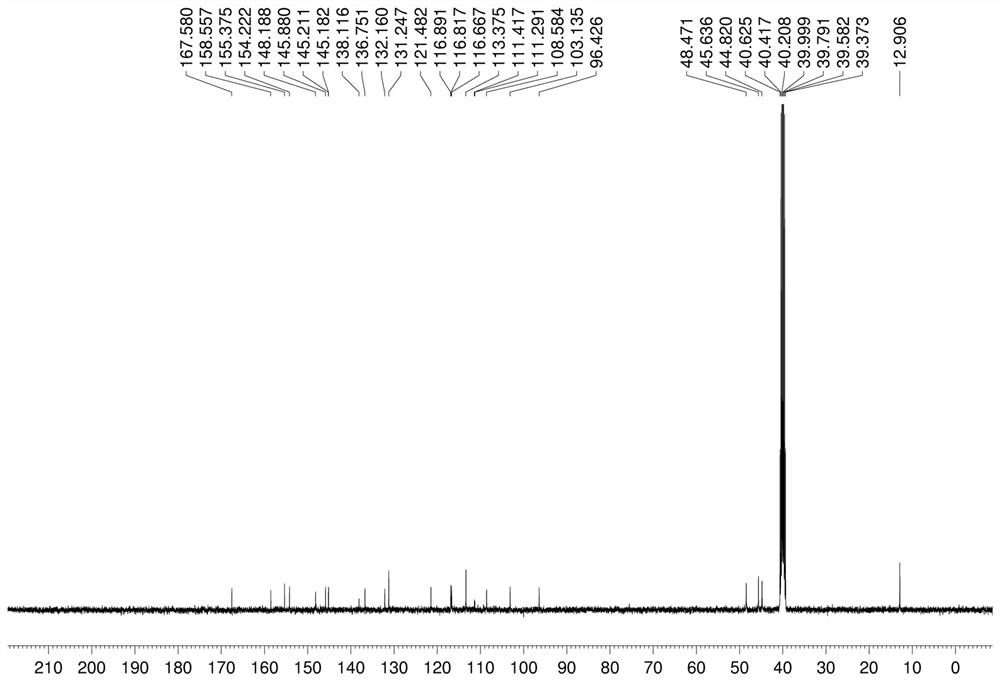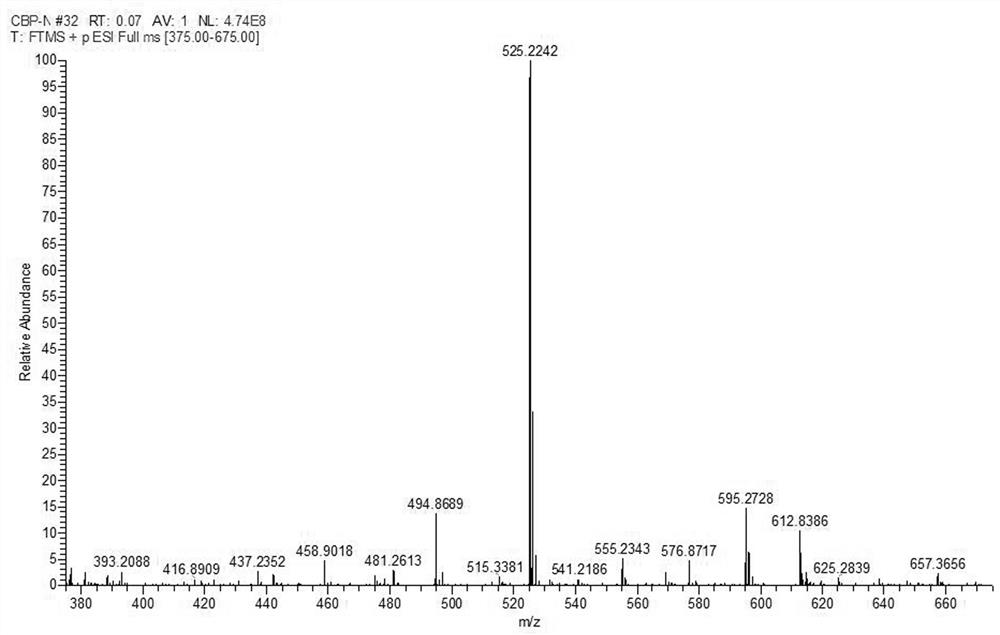A ratiometric fluorescent probe for bisulfite detection and its preparation method and application
A technology of bisulfite and fluorescent probes, applied in the direction of fluorescence/phosphorescence, chemical instruments and methods, luminescent materials, etc., can solve the problems of low sensitivity and low sensitivity, achieve strong anti-interference ability, and simple preparation method , the effect of high yield
- Summary
- Abstract
- Description
- Claims
- Application Information
AI Technical Summary
Problems solved by technology
Method used
Image
Examples
preparation example Construction
[0034] The preparation route and the method of intermediate CBP in the embodiment are as follows:
[0035]
[0036] ① Synthesis of CBP-1: Dissolve piperazine (6 g, 69 mmol) in 30 mL DMF, add potassium carbonate (9.51 g, 69 mmol), stir for 15 minutes, then add p-fluoroacetophenone to the mixture (3.2 g, 2.298 mmol), refluxed overnight at 80°C, after the reaction was complete, the solvent was removed under reduced pressure, dissolved in dichloromethane, washed with saturated sodium chloride, dried over anhydrous sodium sulfate, and the solvent was removed under reduced pressure to obtain CBP-1 , Yield: 55%;
[0037] ② Synthesis of CBP: Weigh 4-diethylaminosalicylaldehyde (193.1 mg, 1 mmol) and CBP-1 (204.1 mg, 1 mmol) in a 25 ml round bottom flask, add 3 mL of concentrated sulfuric acid, 90 °C Heat and stir for 6 h under the conditions; after the reaction is completed, cool to room temperature, add the reaction solution dropwise to 30 mL of ice water, and then add 7-8 drops ...
Embodiment 1
[0039] The preparation method of the ratiometric fluorescent probe used for bisulfite detection in this embodiment:
[0040]The intermediate CBP (181 mg, 0.5 mmol) and triethylamine (70 mg, 0.5 mmol) were dissolved in 20 mL of acetonitrile and stirred for 10 minutes, and 4-chloro-7-nitrobenzofurazan (100 mg, 0.5 mmol) and continued to stir for 10 hours. Spin the reaction solution in the step to remove acetonitrile, redissolve it with dichloromethane (20 mL), wash 3 times with 20 mL of saturated sodium chloride solution, separate the organic phase, dry the organic phase with anhydrous sodium sulfate, filter, and reduce Concentrated under reduced pressure, separated by column chromatography (DCM / MeOH=45 / 1) to obtain 131.3 mg of a dark blue solid, the fluorescent probe CBP-N, with a yield of 50%.
[0041] NMR determination of fluorescent probe CBP-N: 1 H NMR (DMSO, 400 MHz) δ 1.24 (t, J = 6.0Hz, 6H), 3.66 (d, J = 4.0 Hz, 4 H), 3.98 (s, 4 H), 4.38 (s, 4 H), 6.58 (d, J = 8.0...
Embodiment 2
[0044] The preparation method of the ratiometric fluorescent probe used for bisulfite detection in this embodiment:
[0045] The intermediate CBP (181 mg, 0.5 mmol) and triethylamine (140 mg, 1 mmol) were dissolved in 20 mL of acetonitrile and stirred for 15 minutes, and 4-chloro-7-nitrobenzofurazan (200 mg, 1.5 mmol) and continued stirring for 18 hours. Spin the reaction solution in the step to remove acetonitrile, redissolve it with dichloromethane (20 mL), wash 3 times with 20 mL of saturated sodium chloride solution, separate the organic phase, dry the organic phase with anhydrous sodium sulfate, filter, and reduce Concentrated under reduced pressure and separated by column chromatography (DCM / MeOH=40 / 1) to obtain 157.6 mg of a dark blue solid, the fluorescent probe CBP-N, with a yield of 60%.
[0046] NMR determination of fluorescent probe CBP-N: 1 H NMR (DMSO, 400 MHz) δ 1.24 (t, J = 6.0Hz, 6H), 3.66 (d, J = 4.0 Hz, 4 H), 3.98 (s, 4 H), 4.38 (s, 4 H), 6.58 (d, J =...
PUM
 Login to View More
Login to View More Abstract
Description
Claims
Application Information
 Login to View More
Login to View More - R&D
- Intellectual Property
- Life Sciences
- Materials
- Tech Scout
- Unparalleled Data Quality
- Higher Quality Content
- 60% Fewer Hallucinations
Browse by: Latest US Patents, China's latest patents, Technical Efficacy Thesaurus, Application Domain, Technology Topic, Popular Technical Reports.
© 2025 PatSnap. All rights reserved.Legal|Privacy policy|Modern Slavery Act Transparency Statement|Sitemap|About US| Contact US: help@patsnap.com



